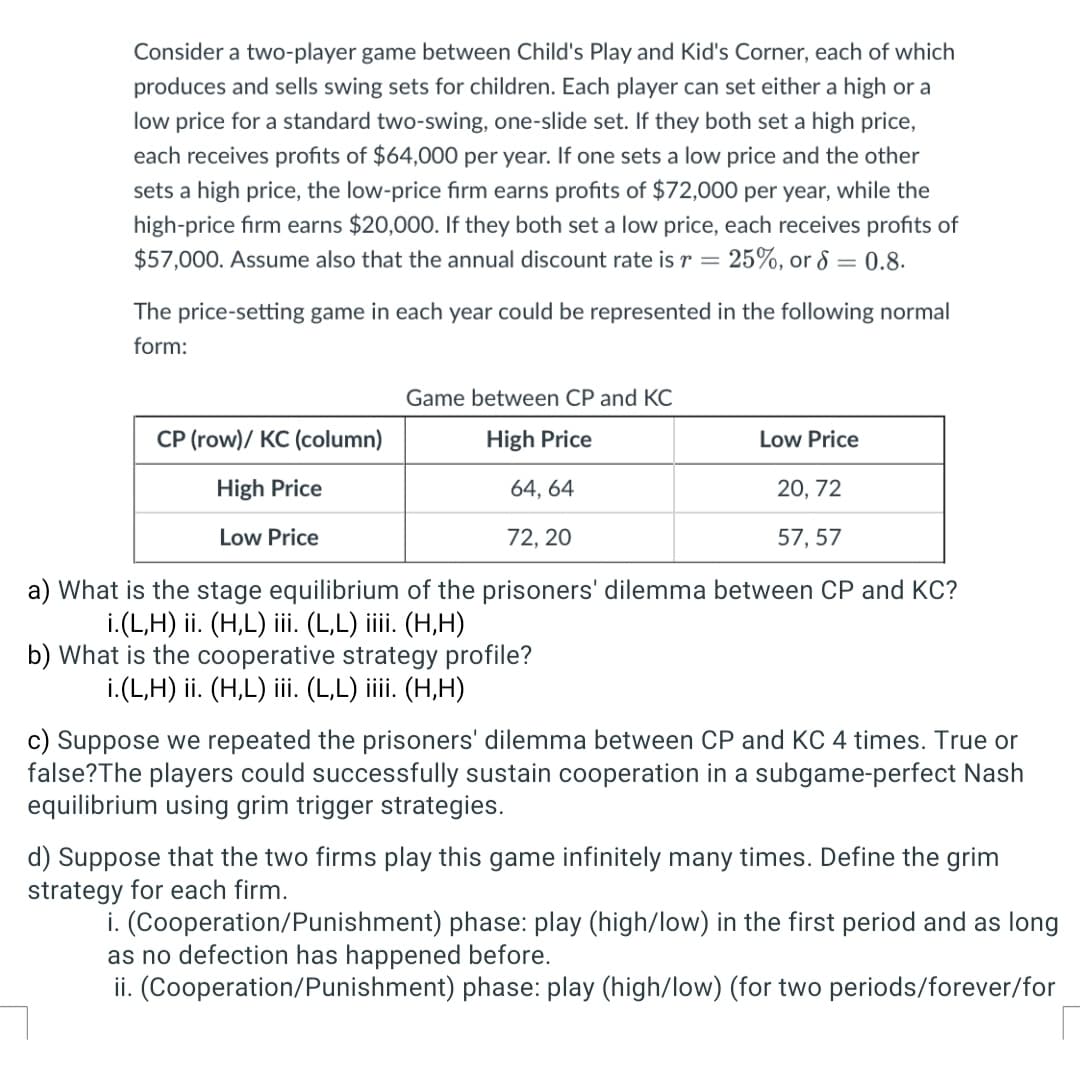Consider a two-player game between Child's Play and Kid's Corner, each of which produces and sells swing sets for children. Each player can set either a high or a low price for a standard two-swing, one-slide set. If they both set a high price, each receives profits of $64,000 per year. If one sets a low price and the other sets a high price, the low-price firm earns profits of $72,000 per year, while the high-price firm earns $20,000. If they both set a low price, each receives profits of $57,000. Assume also that the annual discount rate is r = 25%, or d = 0.8. The price-setting game in each year could be represented in the following normal form: CP (row)/ KC (column) High Price Low Price Game between CP and KC High Price 64, 64 72, 20 Low Price 20, 72 57, 57 a) What is the stage equilibrium of the prisoners' dilemma between CP and KC? i.(L,H) ii. (H,L) iii. (L,L) iiii. (H,H) b) What is the cooperative strategy profile? i.(L,H) ii. (H,L) iii. (L,L) iiii. (H,H) c) Suppose we repeated the prisoners' dilemma between CP and KC 4 times. True or false?The players could successfully sustain cooperation in a subgame-perfect Nash equilibrium using grim trigger strategies.
Consider a two-player game between Child's Play and Kid's Corner, each of which produces and sells swing sets for children. Each player can set either a high or a low price for a standard two-swing, one-slide set. If they both set a high price, each receives profits of $64,000 per year. If one sets a low price and the other sets a high price, the low-price firm earns profits of $72,000 per year, while the high-price firm earns $20,000. If they both set a low price, each receives profits of $57,000. Assume also that the annual discount rate is r = 25%, or d = 0.8. The price-setting game in each year could be represented in the following normal form: CP (row)/ KC (column) High Price Low Price Game between CP and KC High Price 64, 64 72, 20 Low Price 20, 72 57, 57 a) What is the stage equilibrium of the prisoners' dilemma between CP and KC? i.(L,H) ii. (H,L) iii. (L,L) iiii. (H,H) b) What is the cooperative strategy profile? i.(L,H) ii. (H,L) iii. (L,L) iiii. (H,H) c) Suppose we repeated the prisoners' dilemma between CP and KC 4 times. True or false?The players could successfully sustain cooperation in a subgame-perfect Nash equilibrium using grim trigger strategies.
Principles of Microeconomics (MindTap Course List)
8th Edition
ISBN:9781305971493
Author:N. Gregory Mankiw
Publisher:N. Gregory Mankiw
Chapter17: Oligopoly
Section: Chapter Questions
Problem 9PA
Related questions
Question

Transcribed Image Text:Consider a two-player game between Child's Play and Kid's Corner, each of which
produces and sells swing sets for children. Each player can set either a high or a
low price for a standard two-swing, one-slide set. If they both set a high price,
each receives profits of $64,000 per year. If one sets a low price and the other
sets a high price, the low-price firm earns profits of $72,000 per year, while the
high-price firm earns $20,000. If they both set a low price, each receives profits of
$57,000. Assume also that the annual discount rate is r = 25%, or 8 = 0.8.
The price-setting game in each year could be represented in the following normal
form:
CP (row)/ KC (column)
High Price
Low Price
Game between CP and KC
High Price
64, 64
72, 20
Low Price
20, 72
57, 57
a) What is the stage equilibrium of the prisoners' dilemma between CP and KC?
i.(L,H) ii. (H,L) iii. (L,L) iiii. (H,H)
b) What is the cooperative strategy profile?
i.(L,H) ii. (H,L) iii. (L,L) iiii. (H,H)
c) Suppose we repeated the prisoners' dilemma between CP and KC 4 times. True or
false? The players could successfully sustain cooperation in a subgame-perfect Nash
equilibrium using grim trigger strategies.
d) Suppose that the two firms play this game infinitely many times. Define the grim
strategy for each firm.
i. (Cooperation/Punishment) phase: play (high/low) in the first period and as long
as no defection has happened before.
ii. (Cooperation/Punishment) phase: play (high/low) (for two periods/forever/for
Expert Solution
This question has been solved!
Explore an expertly crafted, step-by-step solution for a thorough understanding of key concepts.
This is a popular solution!
Trending now
This is a popular solution!
Step by step
Solved in 2 steps

Knowledge Booster
Learn more about
Need a deep-dive on the concept behind this application? Look no further. Learn more about this topic, economics and related others by exploring similar questions and additional content below.Recommended textbooks for you

Principles of Microeconomics (MindTap Course List)
Economics
ISBN:
9781305971493
Author:
N. Gregory Mankiw
Publisher:
Cengage Learning

Managerial Economics: Applications, Strategies an…
Economics
ISBN:
9781305506381
Author:
James R. McGuigan, R. Charles Moyer, Frederick H.deB. Harris
Publisher:
Cengage Learning

Principles of Microeconomics
Economics
ISBN:
9781305156050
Author:
N. Gregory Mankiw
Publisher:
Cengage Learning

Principles of Microeconomics (MindTap Course List)
Economics
ISBN:
9781305971493
Author:
N. Gregory Mankiw
Publisher:
Cengage Learning

Managerial Economics: Applications, Strategies an…
Economics
ISBN:
9781305506381
Author:
James R. McGuigan, R. Charles Moyer, Frederick H.deB. Harris
Publisher:
Cengage Learning

Principles of Microeconomics
Economics
ISBN:
9781305156050
Author:
N. Gregory Mankiw
Publisher:
Cengage Learning

Managerial Economics: A Problem Solving Approach
Economics
ISBN:
9781337106665
Author:
Luke M. Froeb, Brian T. McCann, Michael R. Ward, Mike Shor
Publisher:
Cengage Learning


Principles of Economics 2e
Economics
ISBN:
9781947172364
Author:
Steven A. Greenlaw; David Shapiro
Publisher:
OpenStax